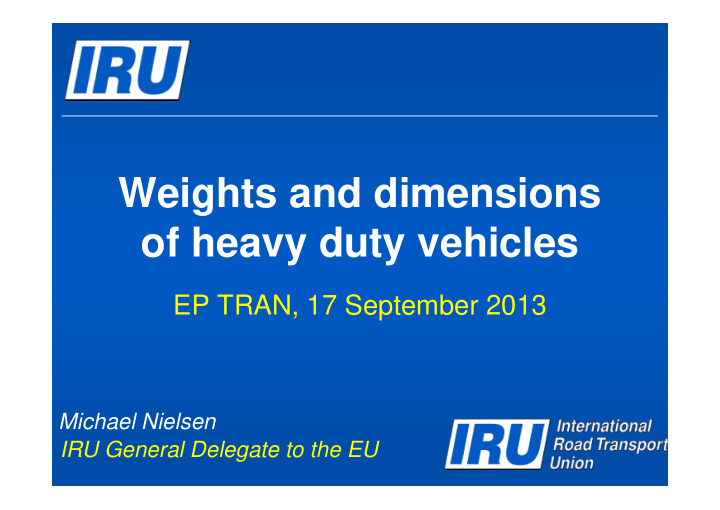



Weights and dimensions of heavy duty vehicles EP TRAN, 17 September 2013 Michael Nielsen IRU General Delegate to the EU
Why revision is needed ! Last revision in 1996 (for goods vehicles) Euro 0 (1990) Euro I (1993) Euro II (1996) Euro III (2000) Euro IV (2005) Euro V (2008) Euro VI (2014) and 2003 (for buses and coaches). 100 90 percentage (1990 = 100) 80 Evolution in safety and environmental 70 60 technology within road transport 50 40 30 How to achieve 2011 EU Transport Policy 20 10 0 White Paper goal (-60% CO 2 emission by CO HC NOx particulates 2050)? Greening at-source for all modes is the only solution. Forced modal shift will never work and a increased use of co-modality will have to happen by co-operation. Page 2 (c) International Road Transport Union (IRU) 2013
What is the revision about? Providing some of the tools to green at-source and improve road safety. • Improve aerodynamics to reduce fuel consumption and CO 2 emissions. • Most efficient for inter-urban, medium and long-distance transports. • Additional length of 2 metres for aerodynamic devices as proposed by EC acceptable. • Weight exemptions for all alternative fuel vehicles (not only electric and hybrid). • Cabin design to improve the safety of the vehicle, driver, load and other road users, especially vulnerable ones. • No loss of carrying capacity - being able to transport more with less. Approach widely supported by directly involved transport stakeholders but also by: T&E, ETF, European Cyclists Federation, Federation of European Pedestrian Associations, European Federation of Road Traffic Victims, Transport for London. In addition: • Increase weight of 2-axle coaches by 1.5 tonnes to improve comfort and promote collective passenger transport to reduce congestion. Page 3 (c) International Road Transport Union (IRU) 2013
The revision is NOT about blocking innovation to protect rail! The rapporteur and UIRR seemingly want to protect Rolling Motorways by restricting aerodynamic improvements and aim to protect railways by blocking the use of EMS. Rolling Motorways only represent 0,17% of EU inland transport (combined transport in total = 1.78%). Should they be allowed to block environmental and safety improvements in the mode that transports more than 75%? Very small competition between road and rail as they transport different types of goods. The rail freight companies are themselves important road hauliers. More than a decade of modal shift policy lead to rail increasing its transport of goods from 386 bn t/km (~20%) to 420 bn t/km (~17%) - loosing thereby close to 3% in market share despite massive political and financial support. Page 4 (c) International Road Transport Union (IRU) 2013
Aerodynamics and EMS • Aerodynamics + EMS = at-source innovation + greener road transport - Reduction in number of trips by 32% - Reduction of fuel consumption by 15% - Reduction of CO 2 emissions by 15% • Aerodynamic EMS is the solution to optimise efficiency & load capacity at- source (CER/Fraunhofer concluded that EMS can reduce • veh/km by 6.3 billion in Germany alone) • Aerodynamic EMS will improve efficiency of multi-modal transport ( proven in Sweden, Finland and demonstrated in Germany ) • Blocking EMS will mean more goods vehicles on the roads • Member States should freely be able to decide on national and cross-border trials with and use of EMS Innovation cannot be blocked in one mode to artificially protect another ! Page 5 (c) International Road Transport Union (IRU) 2013
Conclusion Encourage road transport to green and innovate at-source, just like any other mode! Support more aerodynamic and safer road freight vehicles. Encourage the use of alternative fuel vehicles. Support the increase of weight of 2-axle touring coaches by 1.5 tonnes. Allow Member States freely to decide on trials with and use of EMS (domestic & multiple cross-border). Support the use of EMS in multimodal transport. Do not allow innovation to stall in road transport due to inefficiencies of, or protectionism by, the rail freight industry! Page 6 (c) International Road Transport Union (IRU) 2013
www.iru.org Page 7 (c) International Road Transport Union (IRU) 2013
Recommend
More recommend